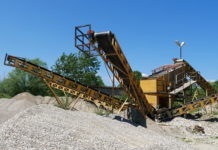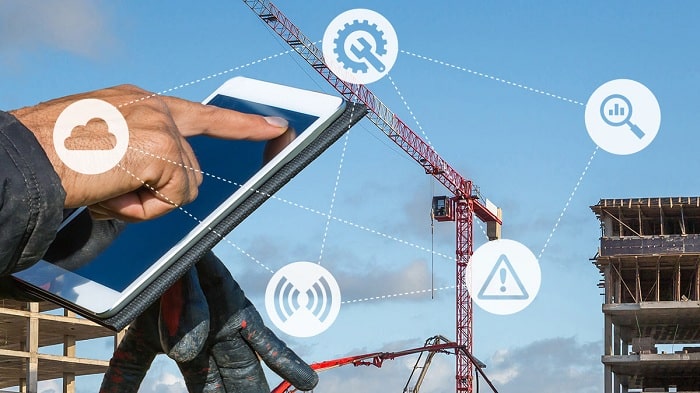The integration of the Internet of Things (IoT) within the construction industry marks a major shift in how projects are approached, executed, and managed. IoT is a wide network of connected devices that can communicate and exchange data. It extends its capabilities to construction sites, transforming them into digital innovation hubs.
This brief exploration aims to illuminate the pivotal role of IoT in construction, emphasizing its impact on enhancing operational efficiency, ensuring worker safety, and paving the way for the creation of smart, sustainable structures.
By harnessing the power of IoT in construction, this sector is poised to overcome traditional challenges, streamline its processes, and step into a future where technology and construction go hand in hand.
IoT in construction
IoT is not a solution looking for a problem; it is the digital transformation that the construction industry needs. The fundamental idea of IoT is to connect devices and gather data in increasingly affordable ways that are applicable to industry needs.
IoT defined
The Internet of Things is a concept that might seem complex at first glance but can be broken down into foundational elements. Essentially, it involves:
- Devices: This includes anything with the capacity to gather, send, or receive data. From sensors embedded in concrete to track curing time and drones for site surveying, to wearables monitoring worker vitals.
- Connectivity: These devices communicate through network connections, leveraging technologies like Wi-Fi, Bluetooth, and cellular networks to transmit data.
- Data processing: Once information is collected, it needs processing and analyzing. This can happen on the device itself or in the cloud, transforming raw data into actionable insights.
- User interface: The insights garnered from data processing are presented to end-users through interfaces. This could be through computer dashboards, smartphone notifications, or automated actions directly controlling other devices or systems on the site.
IoT devices and their influence
When we refer to IoT devices in the construction industry, these could include anything from sensors and GPS devices on vehicles to RFID tags on construction equipment and personnel. These devices allow for real-time data collection and analysis to streamline operations.
Integration in construction
The seamless integration of IoT technologies into construction processes, from pre-construction planning to post-construction monitoring, is redefining the industry. IoT applications are significantly improving areas such as quality control, safety, and, importantly, fleet management.
The state of construction fleet management
Fleet management is a critical, complex component of the construction industry that is ripe for IoT integration. Current methods are often manual, time-consuming, and susceptible to inefficiencies and inaccuracies.
Traditional fleet management practices
Historically, construction fleet management relied on paper logs, manual inspections, and ‘gut-feel’ assessments. This approach was sufficient for a static industry’s needs but is outpaced by the demands of modern construction projects.
Challenges in fleet management
The lack of real-time data and the inherent complexities of construction sites make traditional fleet management susceptible to several challenges like underutilization of assets, breakdowns, and safety concerns that aren’t responded to with the required agility.
The need for tech revolution
With the increasing complexities of construction projects, there is a pressing need for a tech-savvy, data-driven approach to fleet management that only IoT can provide.
Understanding IoT’s role in fleet management
IoT is changing the game in fleet management by shifting it from a responsive to a predictive approach. Data is the new gold, and IoT is the means to mine it efficiently.
Real-time telemetry and asset tracking
Real-time telemetry provides constant streams of data, including the location, performance, and condition of each vehicle, allowing project managers to make data-driven decisions instantly.
Predictive maintenance
Through IoT, managers can track the health of equipment and vehicles, predicting potential issues and scheduling maintenance to prevent costly downtime.
Fuel management and efficiency
Smart sensors and fuel trackers can optimize fuel usage and reduce wastage. Additionally, real-time monitoring can lead to better route planning, further reducing costs and environmental impact.
Performance analytics
IoT in fleet management provides insights into how assets are being used, leading to improved utilization and, therefore, better ROI.
Benefits of integrating IoT in construction fleet management
The advantages of IoT integration into construction fleet management are numerous and impactful. It’s not just about being modern; it’s about being better.
Greater operational efficiency
IoT enables construction companies to streamline their operations, reduce human errors, and increase overall efficiency.
Enhanced safety measures
With IoT, companies can enforce better safety protocols by tracking the locations and conditions of assets in real-time, ensuring the well-being of their most valuable asset—their workforce.
Cost reduction
IoT in fleet management can lead to significant cost savings, from minimizing fuel usage to extending the life of equipment through predictive maintenance.
Environmental benefits
Reducing fuel waste, optimizing routes, and overall increased efficiency can contribute to a decrease in the industry’s carbon footprint.
Improved customer satisfaction
IoT-driven fleet management can improve customer satisfaction by making sure projects are completed efficiently and on time.
Challenges and the future of IoT in construction
While the benefits of IoT in construction fleet management are clear, there are challenges to be overcome. Resistance to change, cybersecurity concerns, and the initial cost of implementation are among the primary hurdles.
Overcoming resistance to change
The shift to IoT-integrated fleet management requires a shift in company culture and comprehensive training programs for employees to utilize the new systems effectively.
Addressing security concerns
The volume of information collected by these devices makes the construction industry a prime target for cyber-attacks. Robust security measures and ongoing monitoring are essential.
Cost of implementation
The upfront costs of IoT integration can be a barrier, particularly for smaller construction firms. However, the benefits over time often outweigh the initial investment.
Infrastructure and technology
A lack of online infrastructure can limit the potential of IoT in construction. Therefore, investments in connectivity and hardware are as critical as the software itself.
Final thoughts
The integration of IoT into construction fleet management is not just a trend but a pivotal shift towards more efficient, safe, and cost-effective operations. Through real-time data and predictive analytics, construction companies can overcome traditional challenges and set new benchmarks for operational excellence.
While obstacles such as resistance to change and cybersecurity threats remain, the potential for IoT to revolutionize fleet management — and the construction industry at large — is undeniable.
Thus, IoT stands as the linchpin for the future of construction, promising a smarter, safer, and more sustainable industry.





































